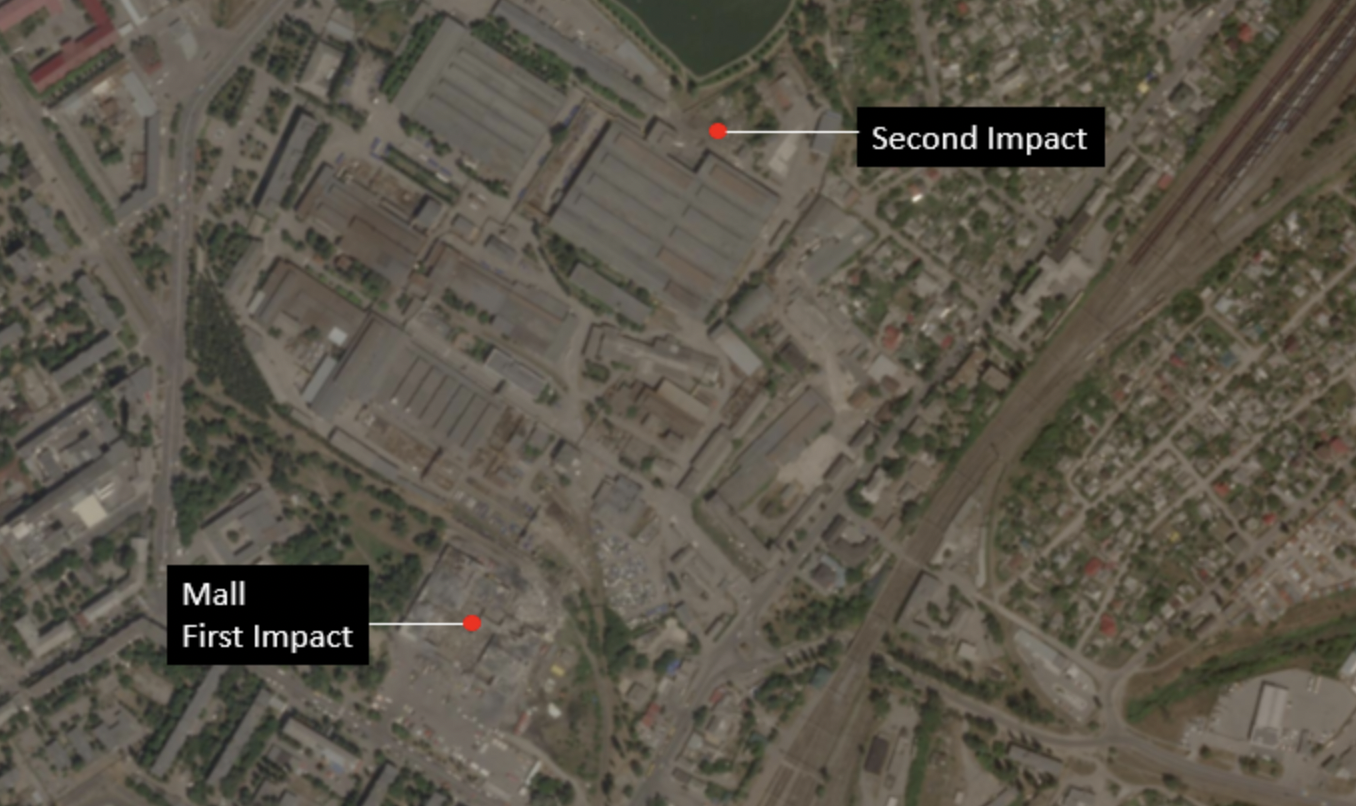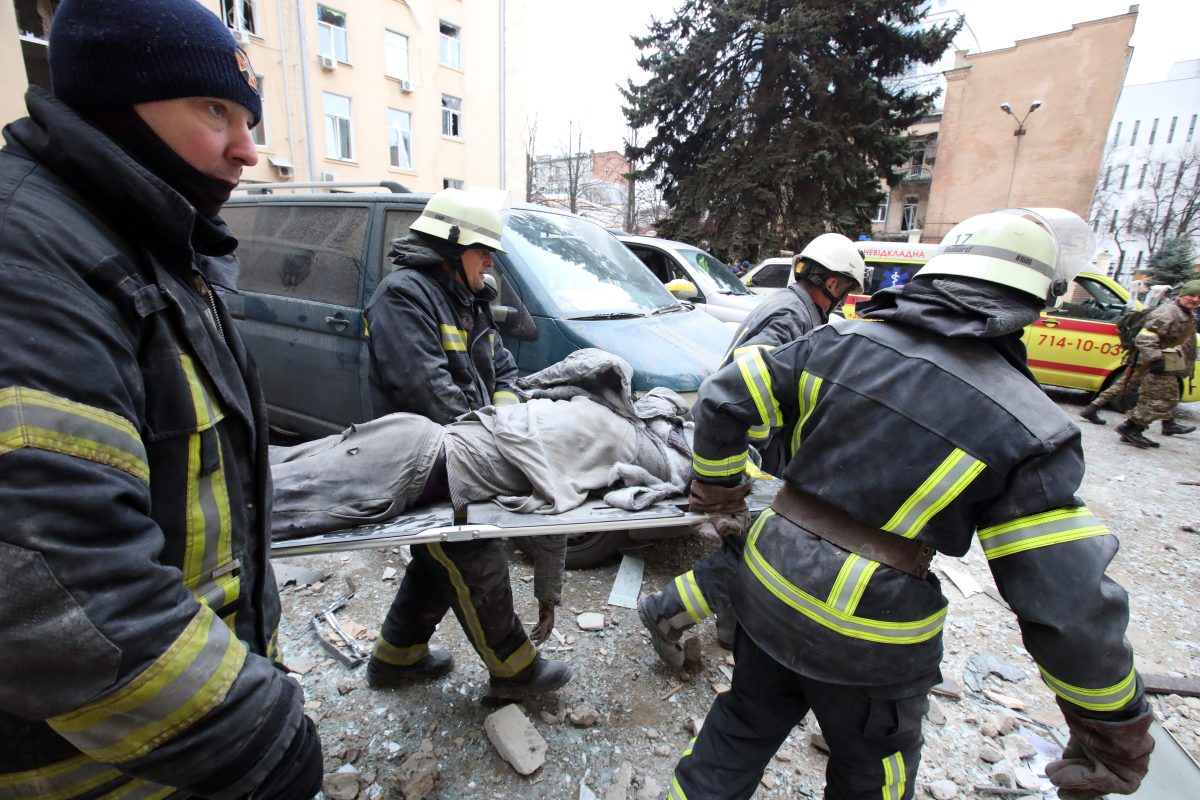Russia’s Kremenchuk Claims Versus the Evidence
On June 27, reports that the Amstor shopping mall in the Ukrainian city of Kremenchuk had been hit in a Russian missile attack began to appear online.
Dramatic images of the facility ablaze soon followed, as did reports of high casualty numbers.
President Volodomyr Zelenskiy of Ukraine stated that there were 1,000 people inside the mall at the time of the attack.
At time of writing, 18 people are reported to have been confirmed dead with more missing.
Reuters reported that Ukraine’s air force command said that the shopping mall was hit by Russian X-22 missiles fired from Tu-22M3 bombers that flew from Shaykovka airfield in Russia’s Kaluga region.
Russian politicians and their supporters promptly justified the attack, at times offering seemingly contradictory explanations.
Late on June 27, Russia’s Deputy Permanent Representative to the UN, Dmitry Polansky, said that the incident was a “provocation” by Ukraine.
He added: “We’ll have to wait and see what our Ministry of Defence says, but there are too many obvious inconsistencies. This is exactly what the Kyiv regime needs to keep the focus on Ukraine in the run up to the [June 28] NATO summit,” in Madrid.
The next day Igor Konashenkov, spokesman of Russia’s Ministry of Defence, said at a press briefing that the country’s air force had carried out a “high precision air attack at hangars where armament and munitions were stored” delivered by the US and European countries at the Kremenchuk road machinery plant, which is a few hundred metres north of the Amstor shopping mall.
The shopping mall, he added, was non-functioning and that it had caught fire as a result of the strikes on targets nearby.
Russian foreign minister Sergey Lavrov also blamed western media for misrepresenting the situation. “The Ministry of Defence has clearly explained it”, he remarked.
However, Vitaly Kiselyev, assistant to the head of the “LNR”, alleged that mall itself was used as an armoury for local territorial defence forces. Similar claims can now be found across social media. Prominent is a pro-Kremlin ‘fact-check’ shared by a Russian embassy account.
Yet as with other claims made by Russia, such as in Bucha and Kramotorsk earlier in the war, these do not appear to be supported by the available open source evidence and videos from the scene.

Map of Ukraine showing the location of Kremenchuk, in the country’s Poltava Region.
What was hit in Kremenchuk?
As the MOD and foreign minister Lavrov’s statements show, Russia does not dispute that the mall was impacted and it admits to carrying out a strike in Kremenchuk.
Footage on social media clearly shows the shopping centre ablaze.
Horror scenes in Kremenchuk, as a Russian missile hits a shopping centre. The man speaking on phone : “people were are the building, the walls are starting to fall in” pic.twitter.com/REDBFmuT3R
— Oliver Carroll (@olliecarroll) June 27, 2022
Later imagery shows it completely burned out with the roof entirely caved in.
Голова ДСНС Сергій Крук : продовжуємо працювати на місці ракетного обстрілу торговельного центру у Кременчуці.
Відомо про 16 загиблих та 59 постраждалих, з яких 25 – госпіталізовані. Інформація оновлюється.
➡️https://t.co/uM7mum9g3w pic.twitter.com/xiQZO4SxvO
— DSNS.GOV.UA (@SESU_UA) June 27, 2022
Yet the Russian MOD’s comments state that the mall was only impacted as a result of the detonation of ammunition which it claimed was stored nearby at the Kremenchuk road machinery plant.
It also claimed a nearby train yard was hit.
⚡💬@mod_russia: On June 27, Russian Aerospace Forces launched a high-precision air attack at hangars with armament and munitions delivered by USA and European countries at #Kremenchug road machinery plant. 1/3 pic.twitter.com/RtDAITZ9DN
— Russian Embassy, UK (@RussianEmbassy) June 28, 2022
Satellite imagery, as well as open source footage videos posted online, appear to contradict those statements.
A selection of CCTV video from the Mis’ky park, which is north of the factory and mall, shows two moments of impact.
Terrifying footage shows the mayhem outside of the shopping mall in Kremenchuk that was struck yesterday by Russian missiles leaving 18 dead.
— Moshe Schwartz (@YWNReporter) June 28, 2022
A freeze-frame from one camera looking south towards the factory shows a plume of smoke (red arrow) in the direction of the Amstor mall.
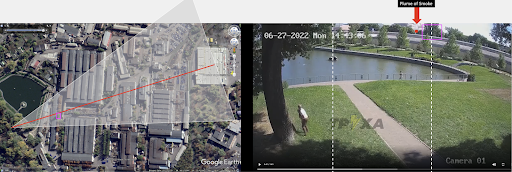
A graphic shows the direction the location of explosions in Kremenchuk. Map source: Google maps. Image source
A few seconds later, a second strike appears to land much closer to the camera with flames clearly visible and reflected on the water.
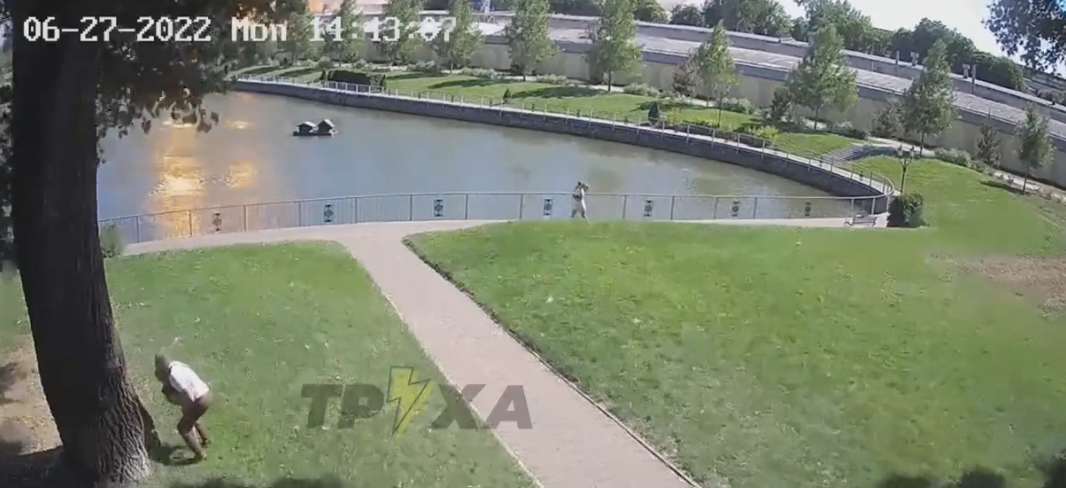
A screen grab from a video posted to Twitter shows an explosion in Kremenchuk.
Satellite imagery confirms the areas that were hit by these missiles.
The below image comparison from the Sentinel-2 L1C satellites shows a comparison of the area around the factory and the mall before (the most recent clear imagery was from May 4) and after the strike.
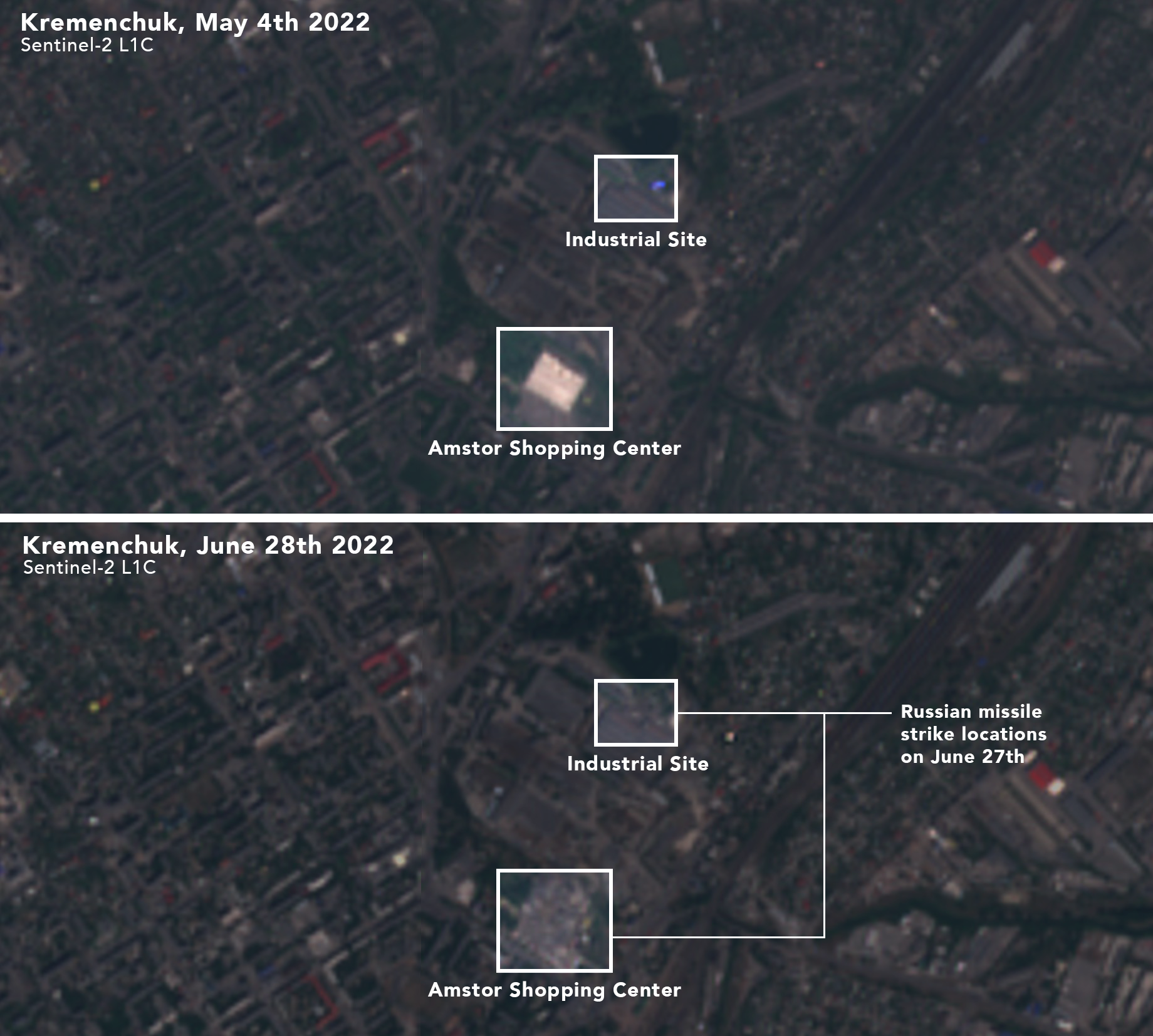
Images captured by the Sentinel-2 L1C satellites show Kramenchuk before and after the June 27 strikes.
The roof of the shopping mall is flattened in the later image while there also seems to have been an impact at the edge of the industrial facility.
There appears to be little noticeable damage to the area in between the two strikes.
This is confirmed by Planet satellite imagery.
Several buildings between the mall and the site of the second impact appear undamaged. The distance between these two points is approximately 0.5 kilometres.

A Google Earth map details the distance between the sites of the two missile strikes in Kremenchuk.
A video shared by an advisor to the Ukrainian presidency late on June 28 appears to show the missile approaching the location of the mall and exploding on impact.
«Абсолютний тероризм», – каже @ZelenskyyUa та публікує відео навмисного удару ракетою по ТЦ в Кременчуку, коли там було багато людей. Російська пропаганда завжди бреше: немає жодної випадковості, це цілеспрямований продуманий удар задля залякування населення та масових жертв. pic.twitter.com/QGKWYwbSZt
— Михайло Подоляк (@Podolyak_M) June 28, 2022
The CCTV camera in the above image can be geolocated here.
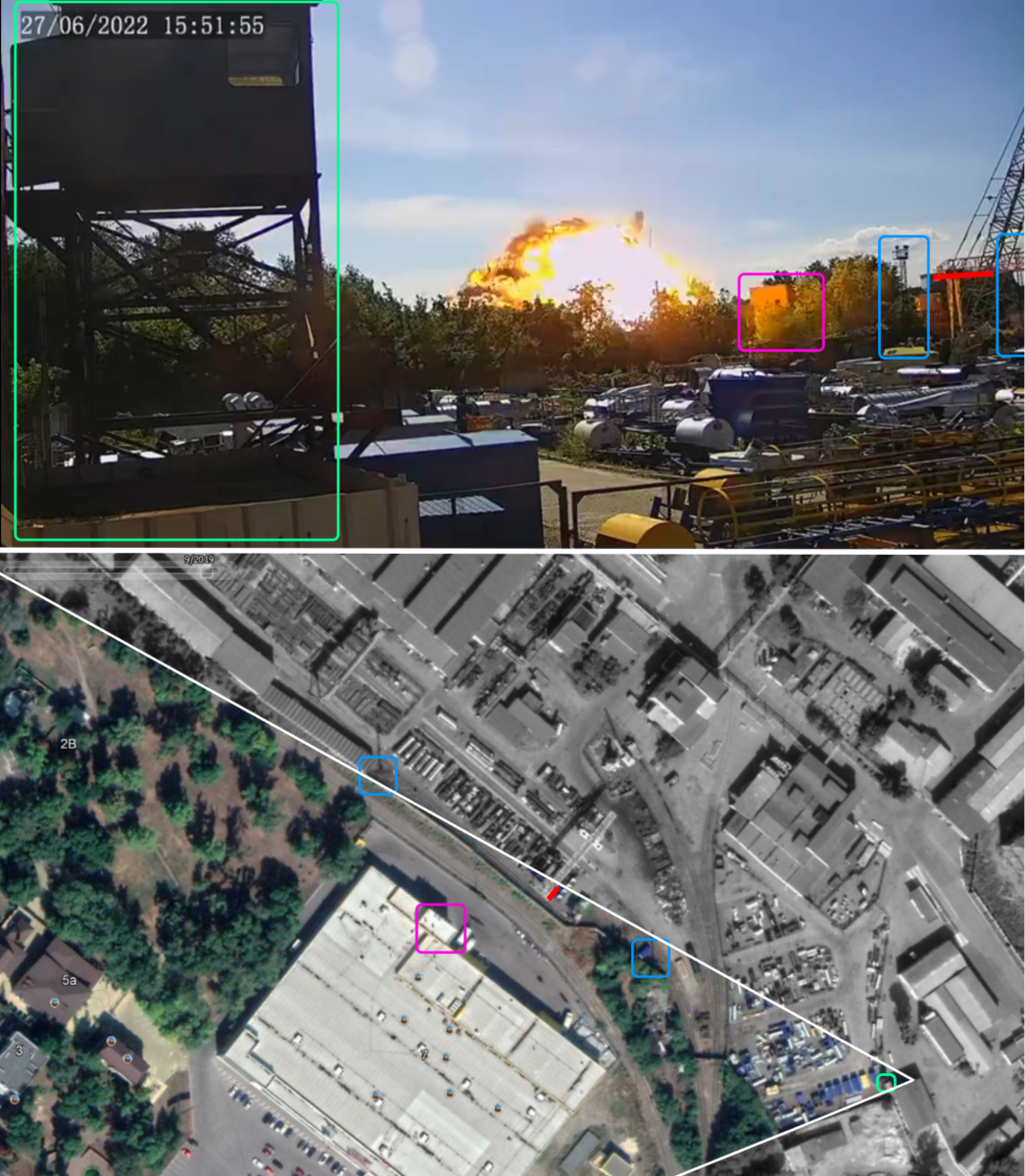
Geolocation of CCTV camera which recorded strike on the shopping mall
This, aligned with the fact that the mall appears to have taken a direct hit given there is no clear or significant impact site anywhere in the area around it, would seemingly undermine Russian MOD claims that a fire spread from the factory area.
Moreover, the fact that multiple explosions could not be observed after the initial impact likely suggests that, in contrast to ‘LNR’ politician Vasilyev’s claim, munitions were not kept at the Amstor building.
A freeze frame of the video even appears to provide a view of the type of missile used.
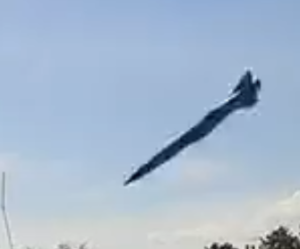
Exactly what was hit within the plant by the second missile is also not entirely clear from open source evidence alone.
A series of smaller buildings visible in YouTube videos appear to populate the area that is detailed as being damaged in satellite imagery.
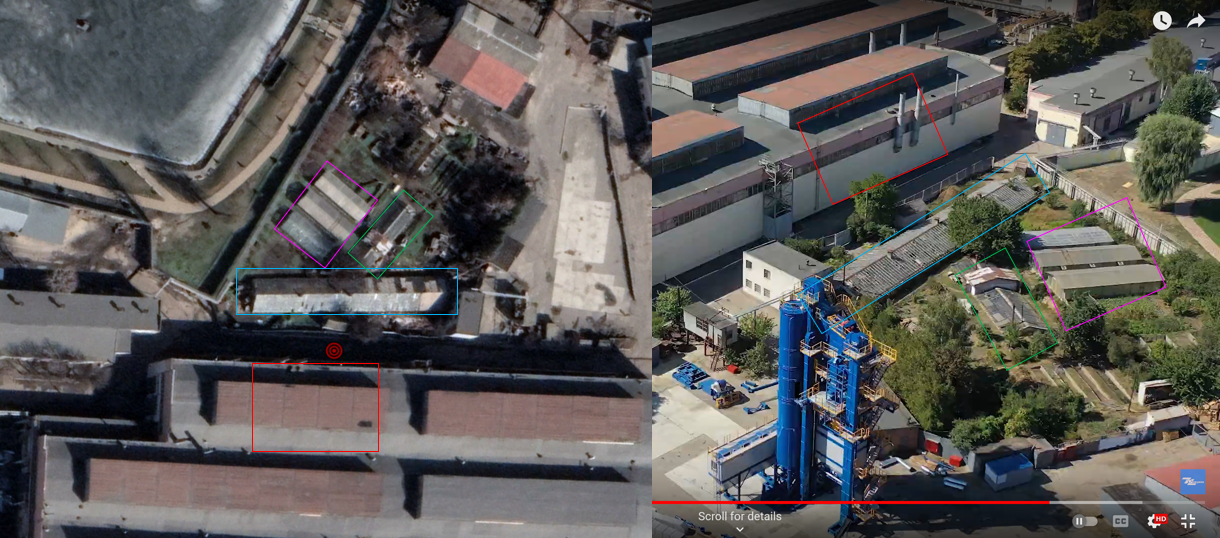
YouTube / Satellite imagery comparison of industrial area
The building highlighted in the red square above also appears to have been damaged, as the GIF below shows.

A GIF showing the damage caused by a missile strike in Kremenchuk.
Although one report in 2014 stated that the factory had been used to repair three military vehicles, this in itself does not prove that it was a storage site for US and European weapons and ammunition eight years later, as Russia has claimed. Vehicles being repaired at the facility would appear to tally up with it being a road machinery plant. Corporate videos taken in recent years show equipment in the plant such as furnaces, cranes and other machinery. It is not possible to verify Russian claims of the plant being an ammo dump from open sources alone.
The area of the factory that was hit is detailed as being the “workshop of the plant and greenhouse” in one regional media report. This is corroborated by one video posted to Facebook by a local, which showed a huge crater at the site of the strike.
Official Russian accounts also shared claims that a train yard nearby had also been hit.
However, Planet Skysat imagery from June 28, taken at 08:51 UTC, shows no sign of any damage to nearby the Kremenchuk train yard located to the east of the Amstor mall.
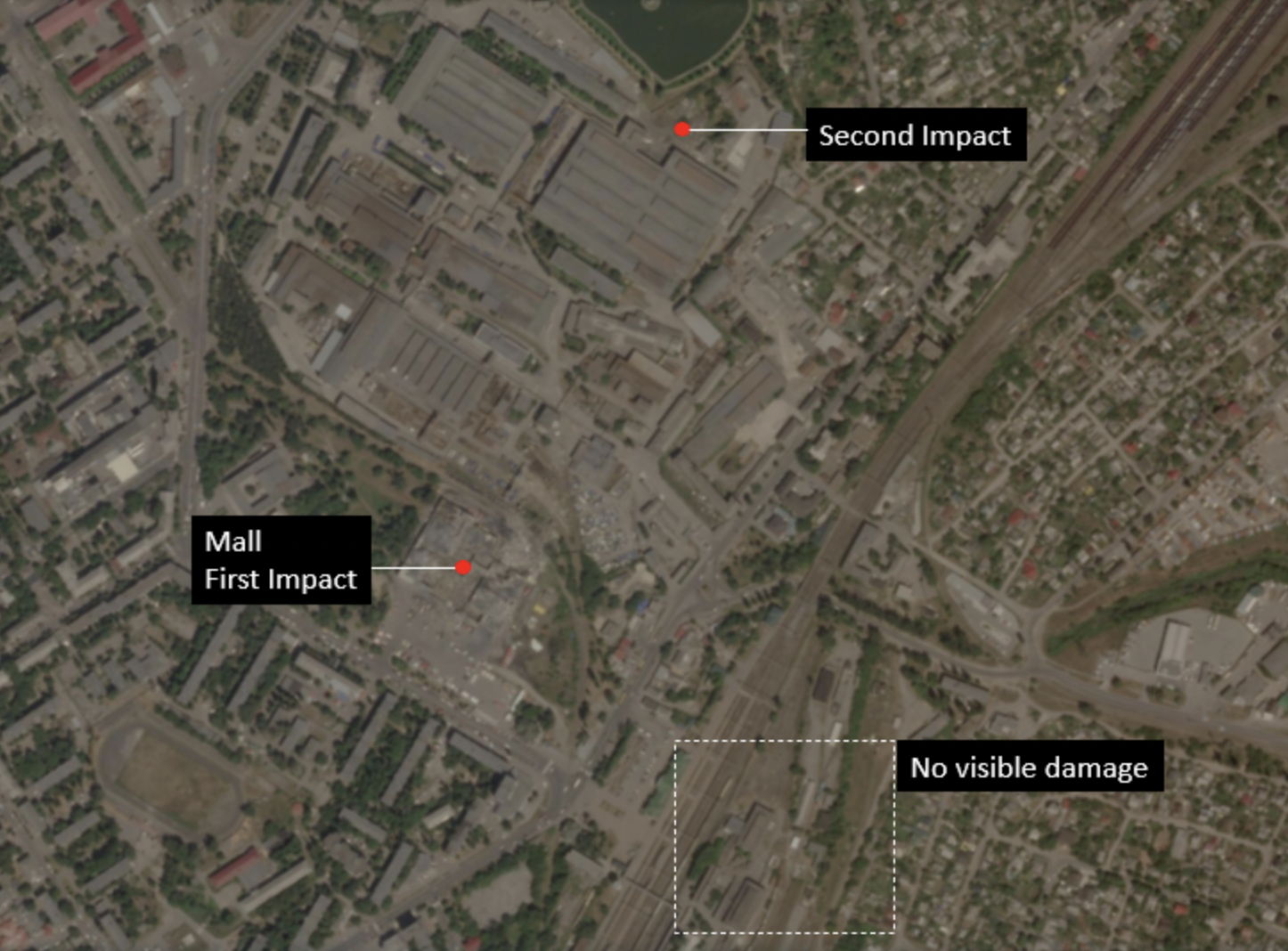
Location of Russian strikes in Kremenchuk on Planet Skysat imagery
Some debris from the strike that hit the mall would likely have impacted a rail line that ran past back of the mall itself.
However, this was not close to where a diagram shared by Russian state accounts, produced by the pro-Kremlin ‘War on Fakes’ project, indicated that it had hit the train yard.
⚡💬@mod_russia: On June 27, Russian Aerospace Forces launched a high-precision air attack at hangars with armament and munitions delivered by USA and European countries at #Kremenchug road machinery plant. 1/3 pic.twitter.com/RtDAITZ9DN
— Russian Embassy, UK (@RussianEmbassy) June 28, 2022
Was the Mall in Use?
Russia also claimed in its reaction to the strike that the mall was not in use.
This claim was echoed by the likes of pro-Kremlin news site LifeNews. It stated that a lack of recent reviews on Google for any other websites over recent months, and a lack of images from inside the mall, showed that it was closed at the time of the strikes.
Yet these claims omit key details to the contrary.
A blog post from the Comfy retail chain from June 25 listed its outlet at Halamenyuk Street 7 in Kremenchuk in a list of shops which had reopened – this is the address of the Amstor shopping mall.
A local Telegram channel shared a screenshot of messages on June 23 from what appears to be a closed Telegram chat group for Amstor employees stating that the shops would continue to work from 8AM to 9PM as usual, despite air-raid sirens.
Some people posted receipts of transactions undertaken at the mall in recent days to show it was indeed open.
Чек из магазина игрушек… за пару часов до 😡 pic.twitter.com/ZH5fUIFDcC
— Serg (@SergZ50534513) June 28, 2022
Then there were posts by stores which stated they had been in operation when the strike happened. Some offered their best wishes to staff who had been impacted.
A post on the Toy House Facebook page on June 28 offered condolences to staff that worked on site and were injured.

Silpo, a Ukrainian grocery store chain, stated that six of its employees were in hospital.

Screenshot from Instagram / SilpoUA
Comfy, the aforementioned retail chain, also stated that one of its employees had died in the attack.

Screenshot from Instagram / ComfyUA
Another business based at the mall, Zerna, posted an Instagram story about the fate of a 19-year-old barista who had been badly burnt in the blaze. The coffee shop’s account shared her mother’s plea for help, in order to cover medical costs.
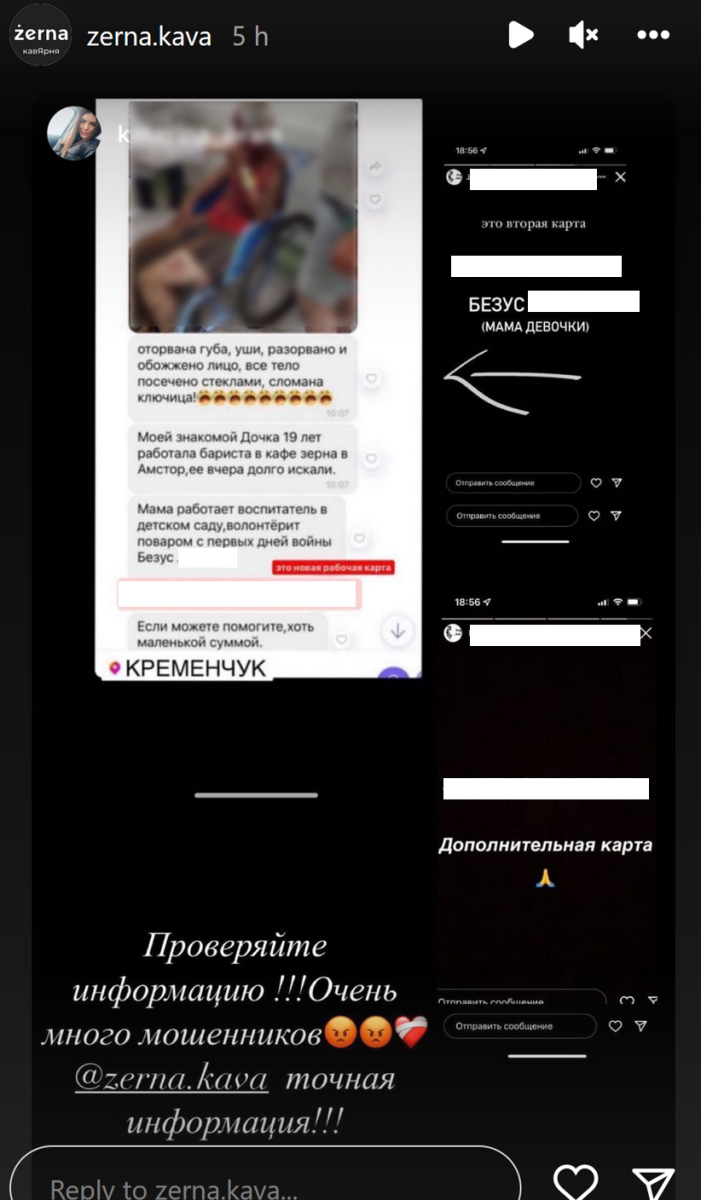
Screenshot from Instagram / Zerna.Kava
The BBC Reality Check team detailed how local Telegram groups had been highlighting that multiple people at the mall were missing in the hours after the attack.
It also pointed to a YouTube video by a Ukrainian family that had purportedly been recorded the day before the attack and showed the mall open. It was posted on June 27.
The pro-Kremlin news website Regnum, as well as the aforementioned ‘fact check’ shared by the Russian Embassy also sought to prove that the mall was closed at the time of the attack – and Zelensky’s claim of 1,000 civilians present – due to the small number of vehicles at the car park.
However, satellite imagery of the mall going back to 2016 shows that, there were many occasions during daylight hours when its car park was sparsely occupied.
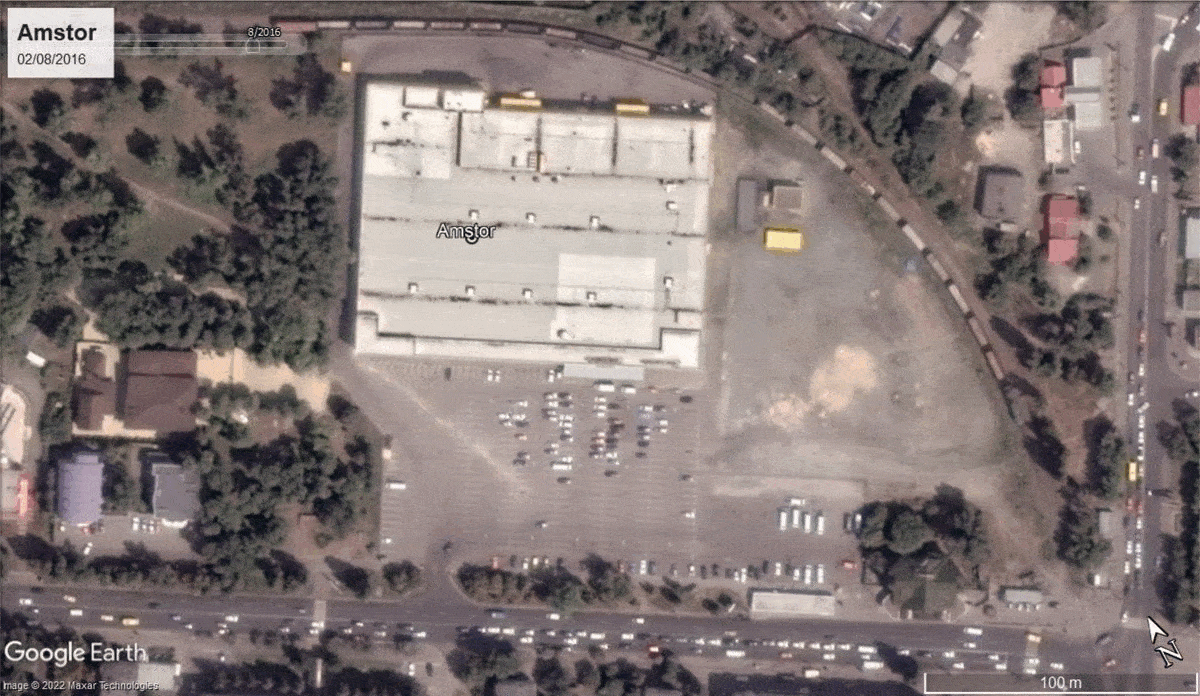
Timelapse images from Google Earth / Maxar Images. Imagery was captured between 11-12AM local time (9AM UTC)
These claims also do not account for the possibility of visitors arriving by public transport. Mapping services show bus, trolleybus and minibus stops in walking distance.
Pro-Kremlin media outlet EurasiaDaily, like the aforementioned ‘fact check’, claimed that only men of military age could be seen at the scene of the explosion. This is also inconsistent with the available open source evidence, in which several women were present after the attack.
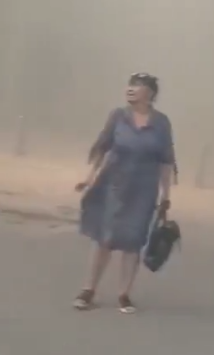
A woman seen outside the shopping mall in Kremenchuk, likely a survivor of the attack. Screengrab from 00:40 in a video taken by a man who escaped the building, shared by Trukha / Twitter.
Furthermore, the presence of some men in military fatigues is not out of keeping with the aftermath of other attacks across Ukraine on civilian infrastructure behind frontlines, in which members of the territorial defence forces have been seen alongside firefighters, medics and policemen.
The aforementioned Regnum article also stated that “there is information that equipment repaired at the nearby Kremenchuk road machinery plant was kept on the territory of the shopping mall”.
Alongside the ‘LNR’ politician Vasilyev’s assertions, the Regnum and EurasiaDaily reports further illustrate a key trend in pro-Russian claims about the strike on Amstor — that the shopping mall was itself a military facility.
None of these sources provided any evidence for this claim, nor has any open source information surfaced which might lend credence to it.
Deflections and Denials
The Russian account of these events presented so far does not tally with the available open source evidence; neither have the Russian authorities provided any verifiable information which could substantiate their claims.
In contrast to claims by the MoD, the open source evidence indicates that the Amstor shopping mall was not destroyed by an explosion erupting from the nearby industrial area. Instead, video footage appeared to show a missile landed directly on the building – a central shopping mall serving a city of 219,000.
At the time of publication, dozens are reported to remain missing.
An earlier version of this story stated that the distance between the mall and the site of the second strike was one kilometre when it is in fact roughly 0.5 kilometres. The story has been updated to reflect this.
Carlos Gonzales, Jake Godin, Annique Mossou, Klement Anders, Maxim Edwards, Eoghan Macguire, Eliot Higgins and Timmi Allen contributed to this report.
Bellingcat is a non-profit and the ability to carry out our work is dependent on the kind support of individual donors. If you would like to support our work, you can do so here. You can also subscribe to our Patreon channel here. Subscribe to our Newsletter and follow us on Twitter here.
